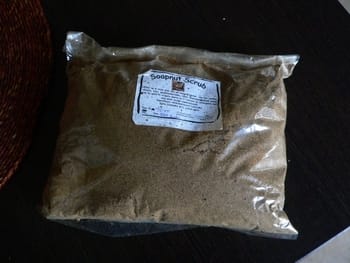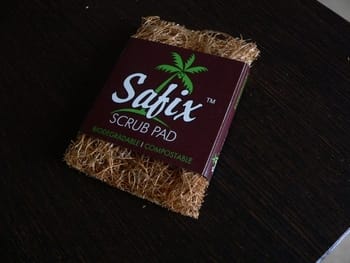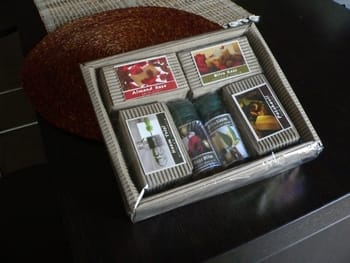The other day, my four-year-old asked for some salt and used lemon peels. "To clean a brass vessel", she told her surprised grandfather! For the next fifteen minutes she was at complete peace (as were the rest of us!) – polishing away till the vessel shone!

Soapnut scrub. Pic: Vinita
This set me thinking about how we had lost touch with so many such simple and natural solutions for home cleaning. So I tried to make a list of what I remembered and what I have tried to re-learn along the way. And to be sure, this is not about nostalgia; it is about finding easy, workable, economical and natural ways to clean
Starting with the kitchen
Washing vegetables – Rather than the commercially available powders/solutions, all we need is a little rock salt to wash our vegetables and fruits, particularly the greens.
Vanastree Soapnut Scrub
vanastree[at]gmail[dot]com, www.vanastree.org
In Bangalore, this product is available at Daily Dump (9916426661)
Washing vessels – We are so used to the liquid soap solution (available in coloured avatars) to wash our greasy vessels that the mere suggestion of anything else would draw resistance. But I would suggest trying a powder made by Vanastree (an organisation working in Malnad region) that uses soapnut , shikakai and dried lemon peels – powdered. It works unbelievably well for even the greasiest of kadhais and vessels.
Stains caused by hard water – For vessels that you use to boil water, for kettles/flasks and vessels with hard water stains, white vinegar works like magic. You could add a 1:1 solution of white vinegar and water in the vessel and leave it for 10-15 minutes. Then wash as normal. The stains disappear and the vessel is good as new. (You could reuse the solution to wash the kettles and flasks)

Safix is made from coconut fibre. Pic: Vinita
Safix is a scrub made of coconut fibre by a local firm. You could try this or better still use coconut fibre itself and after use, put it in your composter.
Cleaning Electronic Appliances – Baking soda mixed with water cleans well and leaves no smell.
Cleaning a refrigerator – Leaving a small uncovered bowl of baking soda in the fridge will help absorb the various odours. Change it regularly to ensure effectiveness. (you can empty the old one in your composter – it will balance the acidity levels caused by citrus peels).
Safix Scrub Pad
This is available in large departmental stores.
Contact manufacturers at
0A, Bommasandra Industrial Area
Hosur Road Bangalore 560099
Email: info[at]inovexenterprises[dot]com, inovexenterprises[at]gmail[dot]com
Namita Rautray – 9845335659, 26683216
Rajkumar Rautray – 9342206462, 41178633
To prevent mold from forming around the edge of the fridge, wiping with white vinegar helps.
Rust can be removed from metal baking dishes by scouring them with half a raw potato and a home-made powder scrub.
Cleaning the floor
I use one of these two options, both available locally – Pynodor (Ullasini) from Osolin and Sunshine Cleaning Liquid (available at most Nilgiris outlets).
Both of these are a mix of various herbs and essential oils. They work well not only for cleaning but also as mosquito repellents and disinfectants in different concentrations (as mentioned on their packaging).
I have also used EM (Effective Microorganisms) for cleaning floors at home. It removes stains amazingly but leaves a faint mark of its own. So one would need to use it with care.
Laundry
Almost every person I speak to about soapnuts (ritha), has used it at some point in their lives – for their hair, woollens, silks, jewellery and so on. Yet, when they hear that I use ritha for laundry, the look of disbelief and a quiet check to see if my clothes are really clean is quite amusing!
Most times it isn’t about using something new, but rather reconnecting with a practice that we have lost somewhere along the way.
One alternative for a laundry soap bar, is the unscented soap offered by Navadarshanam (an organisation located on the outskirts of Bangalore, that explores ecological and spiritual alternatives to the modern way of living and thinking)
Soapnut shells placed in a net pouch or an old sock, tied with a rubber band, can also be used to hand scrub clothes.
On occasion I also make a solution of soapnuts and store it for a week or so. It serves as a multipurpose cleaner – for bathrooms, floors, laundry and so on. See here for more on soapnuts

Eco-friendly soaps for personal care. Pic: Vinita
Personal Care
Frankly there is no dearth of attractive, eco-friendly soaps available in the market today, thanks to the good work of several non-profits and other groups across the country. To name two – Neev Soaps and Sundaram Soaps
There is one soap I came across (it’s made in Kerala, but I have forgotten the name) that comes wrapped in plantain leaf. It was probably the most simple and powerful example of how eco-friendly a personal care product can truly be – if it is well thought through.
So keep it simple and natural – stock up on lime juice, baking soda and white vinegar – and you are good to go!
|
|
What Does it Clean? |
Why Does it Work? |
White Vinegar |
White vinegar is best used to cut grease, clean wood floors and other surfaces like walls and bathroom tiles. It also removes mildew. It’s also a deodoriser. |
Vinegar is actually weakly acidic, making it a powerful cleaning agent. The acid in vinegar cuts through grease found on counter tops. |
|
Baking Soda |
It not only cleans, it also polishes, deodorises and softens water. Baking soda can be used to clean multiple surfaces, jewellery, carpets, ink stains, fish tanks, windows and window screens. It also works well as an air freshener. |
Baking soda is slightly alkaline. It works well as a water softener and can easily break down proteins. It also works well as a deodoriser because it easily neutralizes acidic scent molecules. |
Lemons or Lemon Juice |
Lemon juice is an all-round natural cleaning wonder. It helps remove lime scale, makes windows and mirrors shine. It is used to polish copper or brass vessels, clean kitchen and bathroom surfaces, and remove sweat stains. |
Lemon Juice is one of the strongest food acids and helps kill harmful germs. It also has a refreshing smell. |
⊕
good stuff! wish stuff like this was available at all our neighbourhood smaller stores..
Thanks for the info Vinita! I still do use soapnut…but not exclusively 🙂